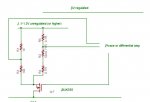Andres Rodriguez
New Member
I need to determine the hfe (gain) value of the transistors that will drive the 1 Amp load. I tried to find the maximum amps from the output pins. The formula I'm using is:
Minimum transistor gain (hfe)=5*(load/max pin current).
I tried to find the max pin current from the 12F683 datasheet and (maybe I did not look in the right places) could not find it.
Any help or suggestions will be amply rewarded.
Thank you in advance
Andrés Rodríguez
Minimum transistor gain (hfe)=5*(load/max pin current).
I tried to find the max pin current from the 12F683 datasheet and (maybe I did not look in the right places) could not find it.
Any help or suggestions will be amply rewarded.
Thank you in advance
Andrés Rodríguez
Attachments
-
4 KB Views: 68
Last edited:


